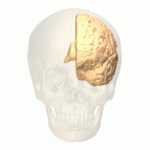Cuneus
| Cuneus | |
|---|---|
 Medial surface of left cerebral hemisphere. (Cuneus visible at left as orange.) | |
 Medial view of a halved human brain | |
| Details | |
| Artery | posterior cerebral artery |
| Identifiers | |
| NeuroNames | 157 |
| NeuroLex ID | birnlex_1396 |
| TA98 | A14.1.09.224 |
| TA2 | 5485 |
| FMA | 61903 |
| Anatomical terms of neuroanatomy | |

- Cuneus (Latin for "wedge"; plural, cunei) is also the architectural term applied to the wedge-shaped divisions of the Roman theatre separated by the scalae or stairways; see Vitruvius v. 4. This shape also occurred in medieval architecture.
The cuneus is a portion of the human brain in the occipital lobe.
The cuneus (Brodmann area 17) receives visual information from the contralateral superior retina representing the inferior visual field. It is most known for its involvement in basic visual processing. Pyramidal cells in the cuneus (striate cortex) project to extrastriate cortices (BA 18,19). The mid-level visual processing that occurs in the extrastriate projection fields of the cuneus are modulated by extraretinal effects, like attention, working memory, and reward expectation.
In addition to its traditional role as a site for basic visual processing, gray matter volume in the cuneus is associated with better inhibitory control in bipolar depression patients.[1] Pathologic gamblers have higher activity in the dorsal visual processing stream including the cuneus relative to controls.[2]
Gallery

References
- ^ Haldane M, Cunningham G, Androutsos C, Frangou S (2008). "Structural brain correlates of response inhibition in Bipolar Disorder I". Journal of Psychopharmacology. 22 (2): 138–43. doi:10.1177/0269881107082955. PMID 18308812.
{{cite journal}}: Unknown parameter|month=ignored (help)CS1 maint: multiple names: authors list (link) - ^ Crockford DN, Goodyear B, Edwards J, Quickfall J, el-Guebaly N (2005). "Cue-induced brain activity in pathological gamblers". Biological Psychiatry. 58 (10): 787–95. doi:10.1016/j.biopsych.2005.04.037. PMID 15993856.
{{cite journal}}: Unknown parameter|month=ignored (help)CS1 maint: multiple names: authors list (link)
This article incorporates text from a publication now in the public domain: Chisholm, Hugh, ed. (1911). Encyclopædia Britannica (11th ed.). Cambridge University Press. {{cite encyclopedia}}: Missing or empty |title= (help)
